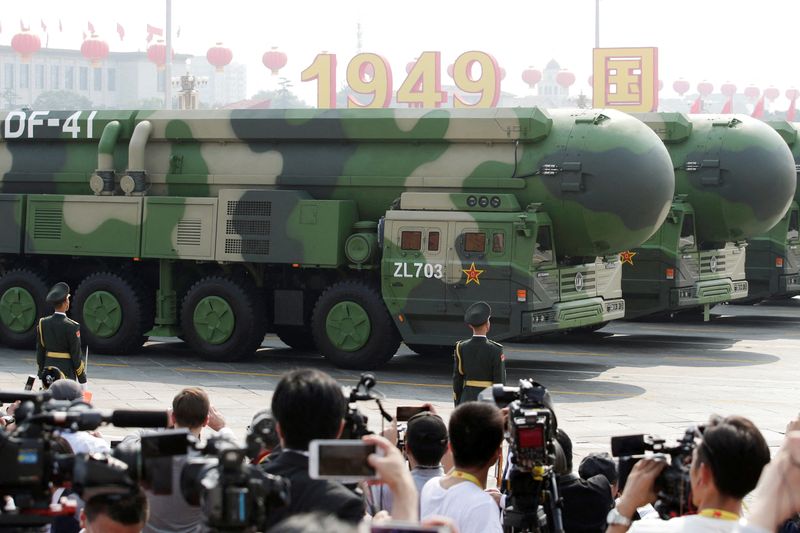China’s PLA conducts rare publicized test launch of intercontinental ballistic missile
2024.09.25 12:23
By Laurie Chen and Ben Blanchard
BEIJING/TAIPEI (Reuters) -China said on Wednesday it had successfully conducted a rare launch of an intercontinental ballistic missile into the Pacific Ocean, a move likely to raise international concerns about the country’s nuclear build-up.
The ICBM, carrying a dummy warhead, was launched by the People’s Liberation Army Rocket Force at 8:44 a.m. Beijing time (0044 GMT) on Wednesday and “fell into expected sea areas,” the Chinese defence ministry said in a statement, adding that it was a “routine arrangement in our annual training plan” and not directed at any country or target.
China notified the United States ahead of the test-launch, a Pentagon spokesperson said, adding it was “a step in the right direction to reducing the risks of misperception and miscalculation.”
China “informed the countries concerned in advance,” according to a separate Xinhua report, which did not clarify the path of the missile or where in the “high seas of the Pacific Ocean” it fell.
The launch “effectively tested the performance of weapons and equipment and the training level of the troops, and achieved the expected goal,” Xinhua reported.
A Japan Coast Guard official said it had received a navigation warning from China on Monday for “space debris” in three zones in South China Sea and the Pacific north of the Philippines’ Luzon island, and in the South Pacific, on Wednesday.
The official declined to confirm whether it was related to the reported missile launch.
It is rare for China to fire long-range missiles into the sea as it prefers to test them unannounced in isolated provinces such as Inner Mongolia, analysts said.
The PLA Rocket Force, which oversees the country’s conventional and nuclear missiles, has been tasked with modernising China’s nuclear forces in the face of developments such as improved U.S. missile defences, better surveillance capabilities and strengthened alliances.
Singapore-based security analyst Alexander Neill said that although confirmed details of the missile used were not yet clear, the test fit a pattern of China simultaneously “engaging and warning”, noting improved military diplomacy between Beijing and Washington in recent months.
Given recent corruption scandals within the Rocket Force, it was important for China to display that it was “business as usual” at the highest military level, he said.
“This move is designed to show in clear terms that the means of delivering its strategic deterrent is still functioning,” said Neill, an adjunct fellow with Hawaii’s Pacific Forum think-tank.
Still, the Pentagon said it wanted a more regularized bilateral notification arrangement for ballistic missile and space launches. It also underscored U.S. concerns about China’s fast growing nuclear weapons arsenal.
“We will also continue to press for substantive bilateral engagement on issues related the PRC’s nuclear weapons expansion and measures to begin to address the risks driven by the PRC’s buildup,” the Pentagon spokesperson said.
‘NO FIRST USE’ POLICY
The PRC, or People’s Republic of China, is the country’s official name.
Some online trackers noted the launch of the missile from Hainan rather than from an inland silo, meaning it was most likely a test of its growing number of road-mobile long-range missiles.
Some analysts say the speed of China’s nuclear build-up goes beyond credible minimum deterrence – the smallest strategic arsenal needed to prevent attacks.
Beijing has for years stuck to a “no first use” nuclear weapons policy, but analysts note the PLA is catching up with major nuclear powers by fielding a nascent triad of weapons that can be fired from land, sea and air.
The Chinese military has emphasised that the Central Military Commission, headed by President Xi Jinping, is the only nuclear command authority.
China, frequently criticised by the United States for the opacity of its nuclear build-up, scrapped nuclear talks with Washington in July over U.S. arms sales to Taiwan.
China has more than 500 operational nuclear warheads in its arsenal, of which approximately 350 are ICBMs, and will probably have over 1,000 warheads by 2030, the Pentagon estimated last year. China’s military is constructing hundreds of silos for land-based ICBMs, the Pentagon said in the report.
That compares to 1,770 and 1,710 operational warheads deployed by the U.S. and Russia, respectively. The Pentagon said that by 2030, many of Beijing’s weapons will likely be held at higher readiness levels.
Democratically governed Taiwan, which China claims as its own territory, has complained of increased Chinese military activities around the island in the past five years.
Taiwan’s defence ministry said on Wednesday it had detected 23 Chinese military aircraft, including J-16 fighters and drones, operating around Taiwan carrying out long-range missions to the southeast and east of the island.

The ministry added it had also recently detected “intensive” Chinese missile firing and other drills, though it did not give details of where that took place.
Taiwan has dispatched its own air and naval forces to keep watch, the ministry said.








